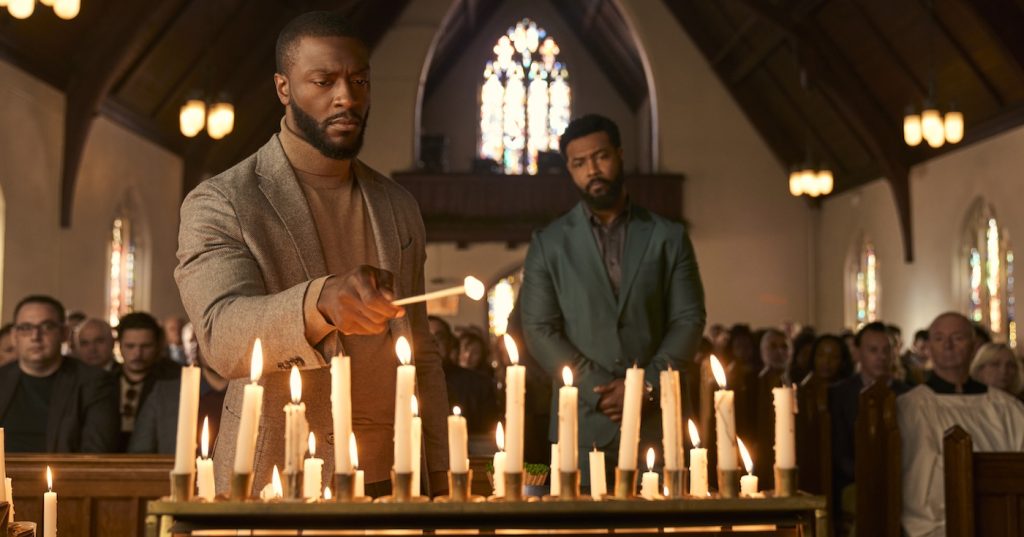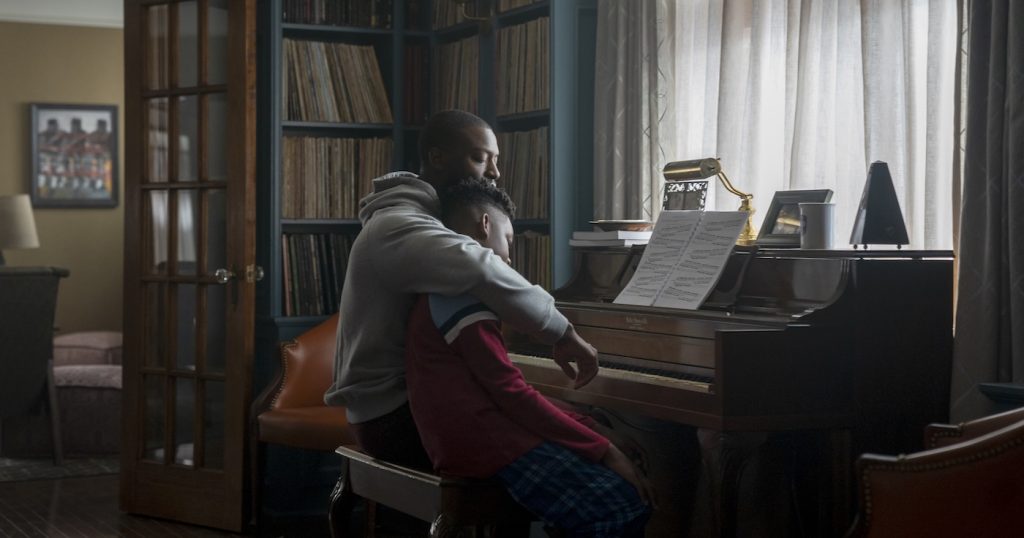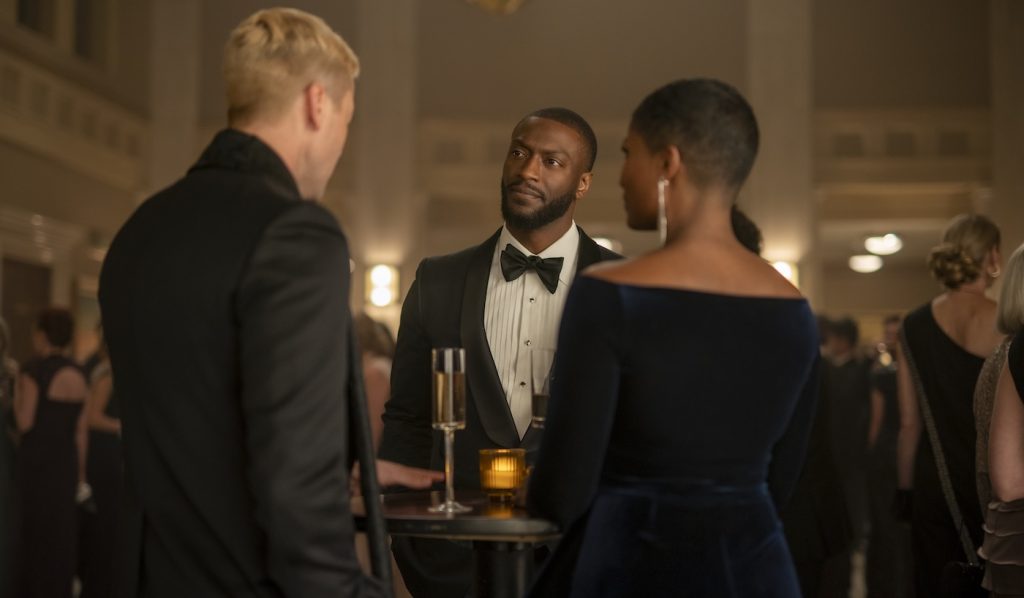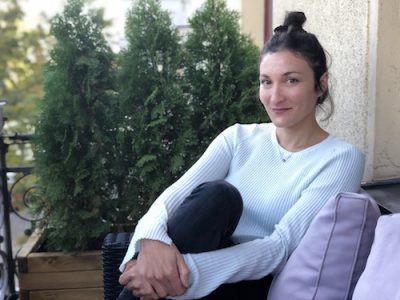Lighting Alex Cross’s World: DP Brendan Steacy on Creating Cinematic TV for Aldis Hodge’s Determined Detective
Created by Ben Watkins for Amazon Prime, the crime thriller Cross feels more like top-tier cinema than a police procedural. Based on James Patterson’s “Alex Cross” novels, the series’ first season (it’s already been picked up for a second) is taut and moody, following D.C. homicide detective Alex Cross (Aldis Hodge) as he pursues a serial killer on the job while struggling in his personal life with the murder of his wife, Maria (Chauntée Schuler Irving).
The villain Alex is after is wealthy and well-connected, reflected in his several torture chambers, including a large basement dark room and then a modern wine cellar, where his trapped victim is surrounded by neat shelves of hundreds of gently backlit bottles. Cross and his partner, John Sampson (Isaiah Mustafa), trek between the police station, Cross’s house, and D.C.’s bars and clubs as they close in on this serial killer-obsessed serial killer. At home, Cross’s children, Damon (Caleb Elijah) and Jannie (Melody Hurd), are looked after by their grandmother, Regina (Juanita Jennings), who does her best to keep everyone safe, despite the looming danger of Maria’s murderer, who seems to be out for further revenge. While navigating difficulties across his personal and professional relationships, Cross finds himself at the center of both unsolved cases.
For cinematographer Brendan Steacy, it was crucial to visually distinguish the detective’s home from the rest of the show’s locations, while ensuring the aesthetic conveyed a Washington, D.C. feel throughout.
We had the opportunity to speak with Steacy about his visual references, the strategic application of light and color, and utilizing cinematography to heighten the on-screen sense of danger.
How did you start off coming up with the show’s cool, moody aesthetic?
When I first met with Nzingha [Stewart, one of the show’s directors] on the pilot, I’d brought a lookbook and references, and as I started showing them to her, she was laughing. We had actually pulled a number of the exact same images. There was a lot of [David] Fincher in both our books. We were on the same page regarding the look and feel, but also wanted to create a version that worked for the story of Cross. It had to be something that could be sustained through the arc of the show. You’re in more spaces, there are more people.

Cross really throws off all the tropes of a typical police procedural.
That was part of what we wanted to do. When Nzingha did her presentation, the first slide she had, she kept saying, it’s not a television show, it’s a movie — we’re going to make it look like a movie. We want it to feel like a movie. It has procedural elements and is a police show, but she drew on references with similar subject matter, albeit with a cinematic direction. That was the starting point.
How do you use cinematography to up the fear factor? For example, a scene that really stood out right away was the silhouette of a knife against the slats of a child’s closet door.
That was a reshoot after the episode had finished. There was initially some concern that it was too difficult to understand what happened to that character. So that was intentionally shot to try and up the stakes, the jeopardy of that child. There was a lot of conversation about how much we should see.
How did you approach the lighting for the basement at 41 Price Street? Was the lighting all practical?
We were really careful with color. It had been decided early on that Ramsey [Ryan Eggold] would have a red light associated with him. Not just red light, but the color red was going to be his thing. The fact that he had a dark room in the basement made it an obvious opportunity to put red in there. So, it was reverse-engineered to determine the practicality of the space, how it would have looked, and then to imagine the utility of that kind of lighting setup, what it would actually look like on camera. I did do a little messing around in there. Elise [Sauve, production designer] built a lot into the set because we wanted to be able to see the whole space and not have too much lighting on the floor. We talked a lot about the design of that overhead lighting. We tried a few different looks. I really wanted to keep it lit by just the stuff that was there, as much as possible. We wound up cheating a little bit — there was some stuff on the floor, and we also taped little valences around the lights so they’re not actually spilling everywhere, playing with the levels so it feels like they’re all on, but one is doing the work and the others are just kind of filling in.
How did you make Alex Cross’s home feel like its own distinct oasis?
It was very important to everyone that his home felt like a warmer, safer environment than all the other places he inhabits. But there were terrifying moments that take place there as well. There are also moments where he’s having domestic problems, so we could adjust levels and play with the overall feeling of the house in those moments. We played with color a little bit. But generally, the house was intended to be a warmer, more inviting, comfortable place for him. It’s where he can be himself, with his family, and then he goes out into this horrible world he has to deal with.

Were there other colors specifically assigned to certain characters or places?
We had palettes that we associated with different environments. The house stayed warm, the police station was cool. When we were supposed to feel the threat of Ramsey, we brought in red light. When they go into the motel, for example, we wanted to signal that they’re in the right place with red light. They don’t know where he is, but his influence is there. We used red light a number of times. The gallery, the first time Shannon [Eloise Mumford] goes on a date with him, has a bunch of red. The red in his dark room. We were saving red carefully for Ramsey moments.

Shooting in Canada, how did you make this look like Washington, DC?
While we were still in prep, we went to DC and shot some exteriors there. It was great, not just because you get some of the expansive shots of DC that give you a clue as to where you are before you go inside smaller spaces, but it was also great for all of us to get a feel for what it was like there, so you have things to reference while looking for spaces.
How was shooting in Canada? Do you work with local crew?
I live here, so I have a lot of people I love to work with and I’ve been working with for a long time. I try to work here as much as I can. It has a pretty strong production community. I do still wind up traveling, and I have a sense of how things stack up. I would say this is a pretty great place to work.
Cross is streaming on Amazon Prime.
For more on Amazon MGM and Amazon Prime Video, check out these stories:
Designing Dance: Production Designer Bill Groom’s Meticulous Ballet World-Building in “Étoile”
Ledgers and Lethal Force: Gavin O’Connor on Directing Ben Affleck in “The Accountant 2”
Featured image: Aldis Hodge as Alex Cross. Credit: Keri Anderson/Prime Video



